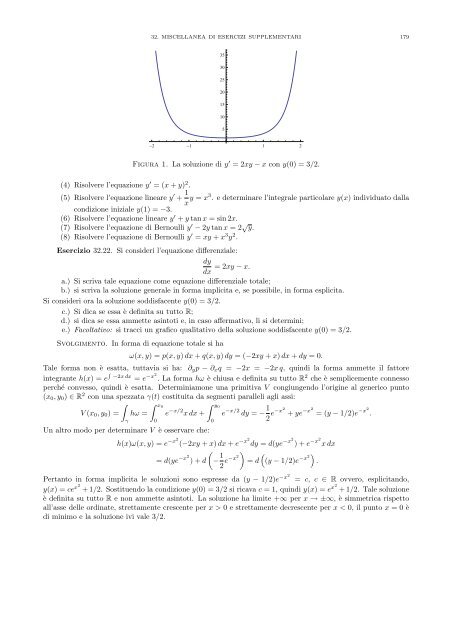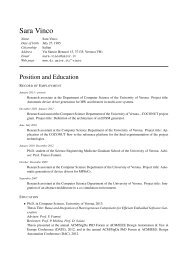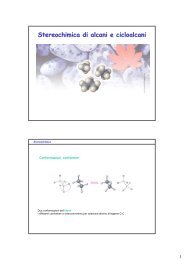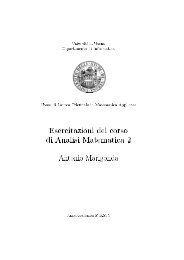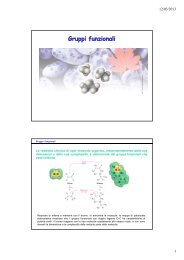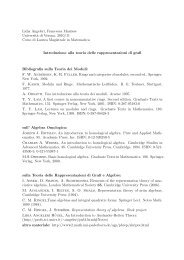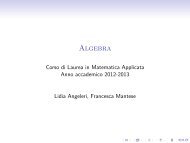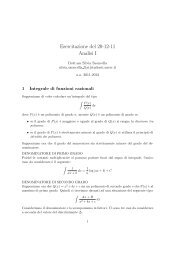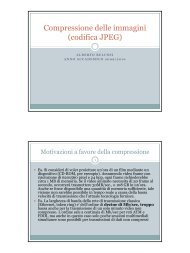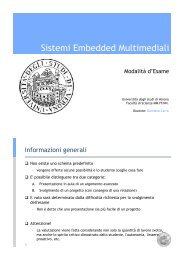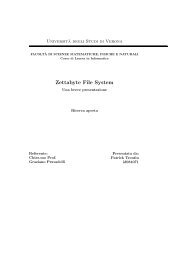You also want an ePaper? Increase the reach of your titles
YUMPU automatically turns print PDFs into web optimized ePapers that Google loves.
32. MISCELLANEA DI ESERCIZI SUPPLEMENTARI 179<br />
35<br />
30<br />
25<br />
20<br />
15<br />
<strong>10</strong><br />
5<br />
2 1 1 2<br />
Figura 1. La soluzione di y ′ = 2xy − x con y(0) = 3/2.<br />
(4) Risolvere l’equazione y ′ = (x + y) 2 .<br />
(5) Risolvere l’equazione lineare y ′ + 1<br />
x y = x3 . e determinare l’integrale particolare y(x) individuato dalla<br />
condizione iniziale y(1) = −3.<br />
(6) Risolvere l’equazione lineare y ′ + y tan x = sin 2x.<br />
(7) Risolvere l’equazione di Bernoulli y ′ − 2y tan x = 2 √ y.<br />
(8) Risolvere l’equazione di Bernoulli y ′ = xy + x 3 y 2 .<br />
Esercizio 32.22. Si consideri l’equazione differenziale:<br />
dy<br />
= 2xy − x.<br />
dx<br />
a.) Si scriva tale equazione come equazione differenziale totale;<br />
b.) si scriva la soluzione generale in forma implic<strong>it</strong>a e, se possibile, in forma esplic<strong>it</strong>a.<br />
Si consideri ora la soluzione soddisfacente y(0) = 3/2.<br />
c.) Si dica se essa è defin<strong>it</strong>a su tutto R;<br />
d.) si dica se essa ammette asintoti e, in caso affermativo, li si determini;<br />
e.) Facoltativo: si tracci un grafico qual<strong>it</strong>ativo della soluzione soddisfacente y(0) = 3/2.<br />
Svolgimento. In forma di equazione totale si ha<br />
ω(x, y) = p(x, y) dx + q(x, y) dy = (−2xy + x) dx + dy = 0.<br />
Tale forma non è esatta, tuttavia si ha: ∂yp − ∂xq = −2x = −2x q, quindi la forma ammette il fattore<br />
integrante h(x) = e −2x dx −x = e 2<br />
. La forma hω è chiusa e defin<strong>it</strong>a su tutto R2 che è semplicemente connesso<br />
perché convesso, quindi è esatta. Determiniamone una prim<strong>it</strong>iva V congiungendo l’origine al generico punto<br />
(x0, y0) ∈ R2 con una spezzata γ(t) cost<strong>it</strong>u<strong>it</strong>a da segmenti paralleli agli assi:<br />
x0<br />
V (x0, y0) = hω = e −x/2 y0<br />
x dx +<br />
γ<br />
Un altro modo per determinare V è osservare che:<br />
0<br />
0<br />
e −x/2 dy = − 1<br />
2 e−x2<br />
+ ye −x2<br />
= (y − 1/2)e −x2<br />
.<br />
h(x)ω(x, y) = e −x2<br />
(−2xy + x) dx + e −x2<br />
dy = d(ye −x2<br />
) + e −x2<br />
x dx<br />
= d(ye −x2<br />
<br />
) + d − 1<br />
2 e−x2<br />
<br />
= d (y − 1/2)e −x2<br />
.<br />
Pertanto in forma implic<strong>it</strong>a le soluzioni sono espresse da (y − 1/2)e−x2 = c, c ∈ R ovvero, esplic<strong>it</strong>ando,<br />
y(x) = cex2 + 1/2. Sost<strong>it</strong>uendo la condizione y(0) = 3/2 si ricava c = 1, quindi y(x) = ex2 + 1/2. Tale soluzione<br />
è defin<strong>it</strong>a su tutto R e non ammette asintoti. La soluzione ha lim<strong>it</strong>e +∞ per x → ±∞, è simmetrica rispetto<br />
all’asse delle ordinate, strettamente crescente per x > 0 e strettamente decrescente per x < 0, il punto x = 0 è<br />
di minimo e la soluzione ivi vale 3/2.


